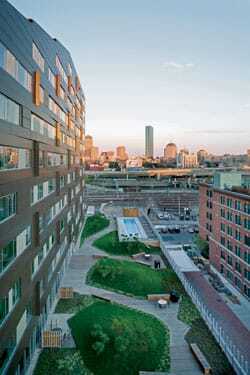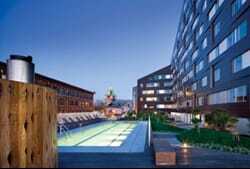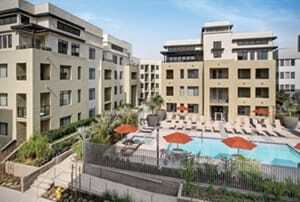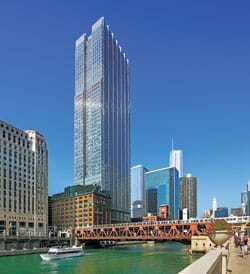As financing for new development has dried up, some might wonder whether public incentives to “go green” have lost relevance in the marketplace.
| The Macallen Building Condominiums, part of the urban revitalization of South Boston, were designed from the ground up to take advantage of green building techniques and materials. |
Community programs to spur green development attracted lots of attention during the real estate boom in the early years of the 21st century. But in 2011, how are local efforts to spur green development faring? A sampling of current city and county programs reveals that many green projects are on hold, but most programs remain in force. More important, they are continuing to attract wide support from the public and interested attention from the development industry. In fact, some cities and counties are proposing to strengthen their incentives and requirements in preparation for a renewal of development activity.
In 2009 and 2010, ULI researchers surveyed green programs in 21 cities and counties to describe the variety of program policies, incentives, and requirements promoting green development. In addition, 41 green projects developed according to the communities’ program standards were profiled. This article focuses on the most recent trends in 11 communities surveyed in the ULI publication State and Local Financing and Incentives for Green Development, published this May.
The current economic recession took effect just as green development programs were achieving liftoff in many communities across the country. With federal and state programs offering tax relief and other inducements, many cities and counties were adopting standards and incentives to encourage green features in public and private developments. In an agreement sponsored by the U.S. Conference of Mayors, more than 500 mayors of American cities pledged to take action in accordance with the Kyoto Protocol on Climate Change of 2005. Also, a host of nonprofit organizations led campaigns to educate local leaders and designers about the benefits of green development. Architects, designers, and engineers promoted the concept through their professional affiliations. Convinced that green features would boost market acceptance, many developers were increasingly willing to incorporate green practices and technologies in their projects.
That was then. Now, developments are being postponed and new ones are slow to appear. Is this bad news for going green? Interviews with key program administrators in the 11 communities surveyed found that local programs are generating significantly fewer green projects, but that they are continuing to support and even expand the concept of sustainable development as a hallmark of community growth and change.
The most bullish reports came from Austin, Boston, Seattle, and Portland, Oregon, where ambitious green development programs continue to generate activity—some visible on the ground, but most in expectation of a busier future.
Austin, which adopted the first comprehensive program in the nation to promote sustainable building in all forms of development, continues to add to its stock of green buildings. The Austin Energy Green Building rating system requires some level of prescribed standards for all municipal buildings and private buildings in specified zoning districts; developments in other areas are encouraged to participate in the program. Sarah Talkington, engineer in the commercial division of Austin Energy Green Building, notes that Austin is not immune to the financial difficulties of the real estate industry, citing a dramatic decrease in the city’s construction activity. However, the slowdown has allowed staff time to prepare annual reports (available at www.austinenergy.com) that summarize the successes of the 19-year-old program. Although 2010 saw fewer new projects, the agency awarded green status to 722 new single-family homes, 971 multifamily units, and 2.65 million square feet (246,000 sq m) of commercial space.
Recognizing that these results are especially impressive in the present economic climate, Austin’s report gives credit for the high rate of program participation to the city’s “culture of environmentalism” and the commitment of local building professionals to green building. For example, in the five years before 2008, homes meeting Austin’s green building standards amounted to about 20 percent of all single-family home construction; in 2010, they represented 38 percent of new homes. In the multifamily sector, units meeting program standards made up 76 percent of those completed in 2010. This year, though building activity has dropped off in the past two months, the Austin Energy Green Building program is “staying pretty busy,” Talkington says.
Boston, which in recent years had been producing significantly fewer green buildings than in earlier years, is recovering market momentum. “The numbers keep going up,” says John Dalzell, senior architect at the Boston Redevelopment Authority (BRA), which administers the program. He notes that the pace of project financing and development has picked up substantially in recent months, likely fueled in part by reduced construction costs and lower interest rates. Dalzell believes that Boston-area developers have largely bought into the concept of green building. Indeed, the numbers tell that story: Boston is now home to 79 projects certified under the Leadership in Energy and Environmental Design (LEED) program and totaling over 19 million square feet (1.8 million sq m) of building area, including 32 Gold-rated buildings. Another 117 projects totaling almost 60 million square feet (5.6 million sq m) are in planning or construction and are seeking LEED certification.
Although many green buildings are located in the financial district and the South Boston waterfront, a substantial proportion is being developed in other parts of the city.
Recognizing the market’s acceptance of green building, BRA is planning policy expansions to place greater emphasis on project form, bulk, and environmental implications and is expecting to reduce the threshold for green buildings to 20,000 square feet (1,900 sq m) within a few months.
Portland’s approach to the current economic climate is remarkably similar to Boston’s: planning ahead to stimulate more contextual green development. Alisa Kane, green building and development manager in the city’s new Bureau of Planning and Sustainability, says Portland’s experience echoes that of some other cities: not much activity in commercial development but an increase in residential retrofits, especially for subsidized housing, and institutional construction. The 2010 award of $20 million in federal American Recovery and Reinvestment Act funding for Oregon and Portland will spur clean energy retrofits throughout the city. Kane says Portland is also updating its comprehensive plan to prepare for expected growth and is moving toward a more holistic, contextual approach to neighborhood development.
Seattle is continuing to support programs that offer incentives for higher density and more residential development in downtown. The density bonus prompted a building boom in the downtown core because developers could generate as much as twice the floor space previously allowed. Most projects have focused on the residential market. Unlike the case in Boston, few new projects are being pursued at present. But Jayson Antonoff, the city’s energy/climate policy adviser, says the enthusiastic response to the density incentive has led to adoption of new mandates for green development. A new program calls for measuring and disclosing the energy performance of high-rise buildings, with the first annual reports due this October. Initially, buildings of 50,000 square feet (4,600 sq m) or more are required to report energy use, but the program calls for future extension of the program to cover buildings of 10,000 square feet (930 sq m) or more, as well as multifamily buildings.
Furthermore, according to David LaClergue, an urban designer in the planning department, the city is expanding applications of landscaping standards to more areas and types of development. Called the Seattle Green Factor, the program establishes a scoring system to promote use of permeable paving and improved landscaping in commercial zones and, since 2010, multifamily zones. Seattle is adopting ideas from Berlin and Malmo, Sweden, to “retool landscaping standards,” LaClergue says. City officials are not expecting a backlash to beefing up standards, Antonoff says; developers appear willing to build to higher standards, and Seattle’s residents now expect them to do so.
Arlington County, Virginia, across the Potomac River from Washington, D.C., continues to provide density incentives in return for compliance with LEED standards. “The incentive has been very popular over the past several years,” says Joan Kelsch, who manages the optional program. She reports that 38 percent of development projects (23 of 60 new buildings) approved by the Arlington County Board since 2005 have participated in the program, and since 2008 participation rates have increased to 58 percent. This year some developers are seeking density increases due to rising land costs, she believes. Furthermore, if developers wish to attract federal tenants, they must attain LEED Gold certification. However, says Kelsch, more developers are achieving LEED Silver (or higher) certification without the incentive, either to remain competitive in the Washington area market or because the bonus density is not available in the zoning for their project. Due to the county’s central location in the Washington area, building sites are expected to command premium prices, so developers are likely to continue seeking permission for higher-density development in return for achieving LEED standards. “The program has done its job—moving the market toward green,” Kelsch concludes.
| The Westgate Apartments in Pasadena, California, were designed as an environmentally friendly urban community promoting healthy living and sustainable practices. |
Pasadena, California’s voluntary green program, which aided redevelopment of the historic downtown and generated many residential projects, is also feeling the pinch of scarce project financing. Alice Sterling, until recently the city’s Green Cities project manager, reported that developers of many large buildings approved by the program have requested extensions of their building permits. However, the California Institute of Technology has initiated construction of four buildings, based on state funding, and construction of a privately financed medical office building has slowed but has not stopped. Ongoing construction of the Sares-Regis Group’s first-phase, 480-unit residential development is well on its way to completion. Sterling noted that no pressures have arisen to make significant changes in the program, nor had she heard from the industry that green features are deal breakers in Pasadena.
That conclusion seems to echo current experience in Scottsdale, Arizona, where construction activity also slowed as financing difficulties arose. Scottsdale’s voluntary green program has produced a number of well-designed projects in recent years. Most recent activity, however, has been occurring at a slower pace and is focused on building new homes or retrofitting existing homes. Anthony Floyd, senior green building consultant for the city, says the good news is that about 40 percent of new and renovated units meeting green standards are installing solar power systems, an impressive increase from just a year or two earlier. Also, the city is continuing to design public buildings to meet LEED standards, including three fire stations, plus a library and a new trailhead building. Some multifamily projects such as Optima Camelback are gradually upgrading units to meet LEED standards, and two green office projects have earned LEED certification. Floyd suggests that Scottsdale’s development slowdown may be due in part to the city becoming built out, while many sites are available in nearby newer communities such as Buckeye and Goodyear. However, he emphasizes that green building remains an important goal for future development in Scottsdale.
The smaller communities represented in this survey exhibit a variety of trends in green development. Building activity in Aspen and Pitkin County, Colorado, has waned, but both jurisdictions are seeing expanded activity in home renovations and upgrades. The Aspen Daily News reported in April 2010 that the number and value of building permits in the city had declined, a factor due to “less intense, less involved, and more modest” projects. In mid-2011, however, Denis Murray in the city’s building department notes that development activity has picked up almost to the 2007 level due to a surge in high-value custom homebuilding and construction of a large new hospital. In Pitkin County, though, county records show that the value of permitted construction is sagging, with development limited mostly to kitchen and other renovations in existing homes. Although Aspen replaced its Efficient Building Code with the International Energy Code in 2009 and both jurisdictions have pared back staff, Tony Fusaro, the county’s chief building official, comments that local officials believe that most developers see green development as “the way to do business” rather than just another requirement for a permit.
| Located on the north bank of the Chicago River in the near North Side area of Chicago, 300 North LaSalle is seeking LEED Gold certification by incorporating environmentally friendly and energy-efficient materials and systems. |
Normal, Illinois, which adopted requirements for green building in its central area in 2001, has generated several LEED-rated green public projects and privately sponsored projects, including a bank and a drugstore, a mixed-use development that includes student housing next to the Illinois State University campus, and other projects that are underway. The city’s planner, Mercy Davison, counts a total of nine projects completed or under construction and another planned but not yet initiated. The city has also completed major upgrading of downtown streets and underground utilities, and just won federal grant funding for a multipurpose transportation center. Although a new city council, citing property rights and other issues, has replaced the green requirements with a set of interim design guidelines, Normal has moved decisively toward green development.
Perhaps predictably, green building in Grand Rapids, Michigan, which in past years had generated an impressive 61 LEED-certified projects, has been stymied by the state and local economic malaise. Still, the city has committed to promoting green building through the comprehensive planning process rather than strict requirements. Planning director Suzanne Schulz, characterizing the city’s approach as “a new way of doing business,” cites many initiatives, including green design of public buildings and ongoing public support for bike paths, expansion of open space, and an improved tree canopy. However, developers facing a financing hurdle are increasingly reluctant to meet LEED requirements, says senior planner Landon Bartley, and current private investments are focused more on improving existing buildings than initiating new projects.
The final example of experience with green development kindles hope for the continued expansion of green building throughout the nation. Cambridge, Massachusetts, adopted a climate protection plan in 2002, then required new municipal construction and renovations to achieve LEED standards and formed an energy alliance with a nonprofit foundation. In August 2010, after lengthy citywide discussion, the city adopted a sustainable design and development article that established LEED standards for new construction or substantial rehabilitation of all developments of 25,000 square feet (2,300 sq m) of floor space or more.
These reports from places promoting green development indicate that local jurisdictions are finding ways to keep programs alive.








